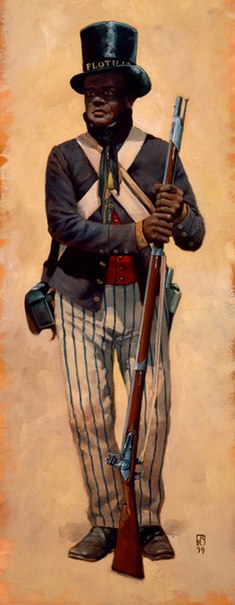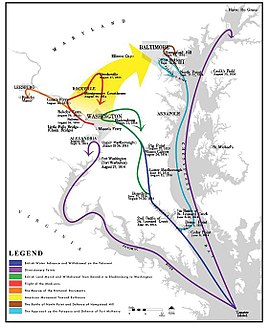| Chesapeake Bay Flotilla | |
|---|---|
 Charles Ball wearing the uniform of the Chesapeake Bay Flotilla. | |
| Active | 1813-1815 |
| Country | |
| Allegiance | |
| Branch | |
| Role | artillery |
| Size | 4,370 men (with an additional 700 U.S. marines attached to naval force) |
| Part of | U.S. Department of the Navy |
| Engagements | War of 1812
|
| Commanders | |
| Notable commanders | Commodore Joshua Barney |
| Chesapeake campaign | |||||||
|---|---|---|---|---|---|---|---|
| Part of War of 1812 | |||||||
 | |||||||
| |||||||
| Belligerents | |||||||
|
|
| ||||||
| Commanders and leaders | |||||||
| Joshua Barney |
Sir George Cockburn Sir John Warren Alexander Cochrane Robert Ross | ||||||
| Strength | |||||||
|
4,370 sailors Ships:
|
Large: 96 Ships:
| ||||||
| Casualties and losses | |||||||
|
Artillery Scuttling and burning of Flotilla vessels | minimal | ||||||
The Chesapeake Bay Flotilla was a motley collection of barges and gunboats that the United States assembled under the command of Joshua Barney, an 1812 privateer captain, to stall British attacks in the Chesapeake Bay which came to be known as the "Chesapeake campaign" during the War of 1812. The Flotilla engaged the Royal Navy in several inconclusive battles before Barney was forced to scuttle the vessels themselves on August 22, 1814. The men of the Flotilla then served onshore in the defense of Washington, DC and Baltimore. It was disbanded on February 15, 1815, after the end of the war.